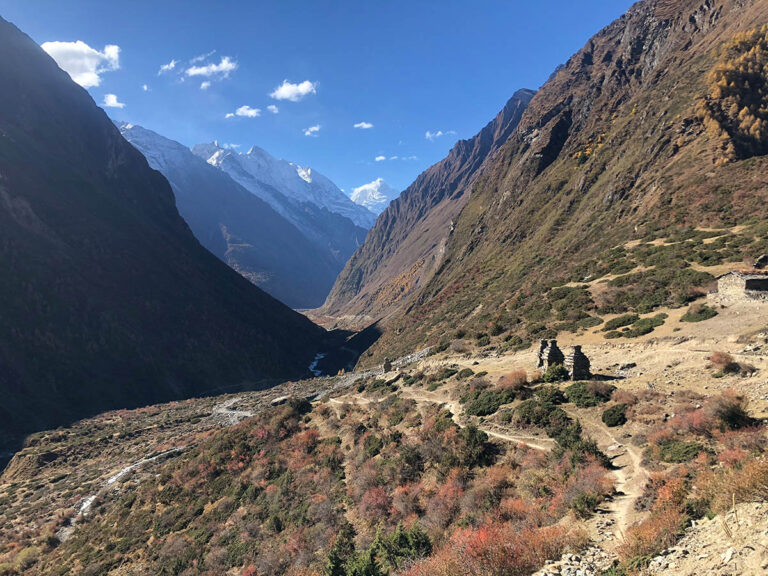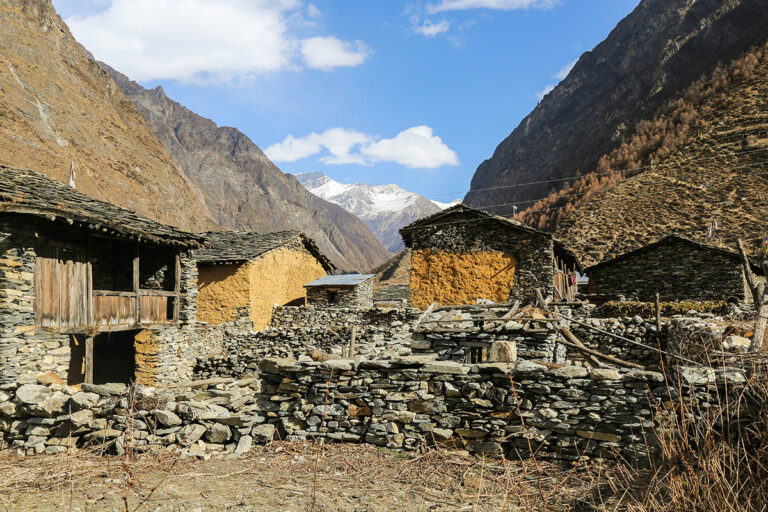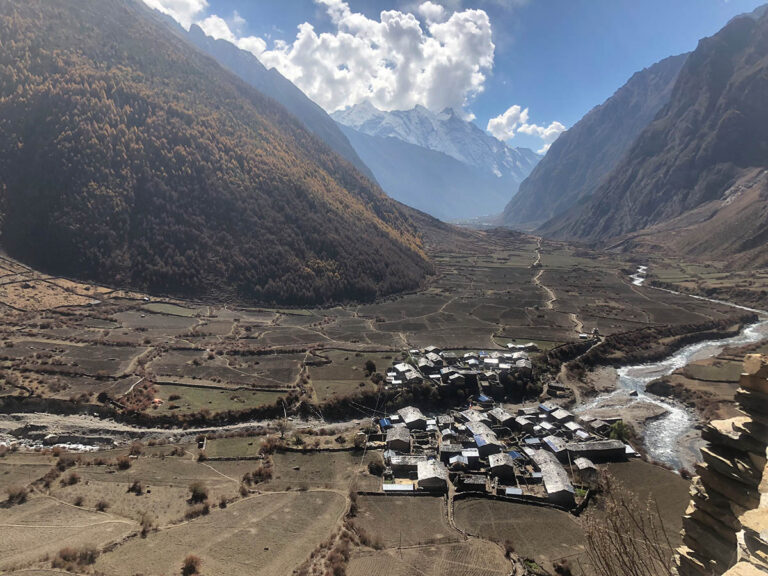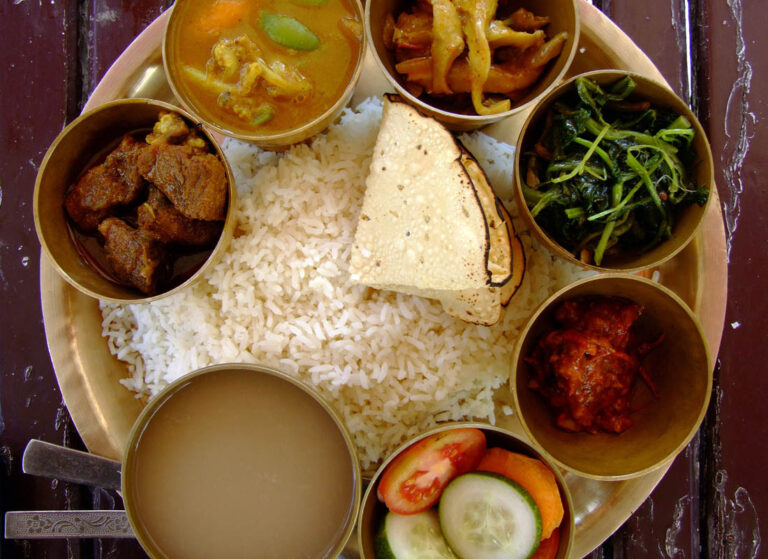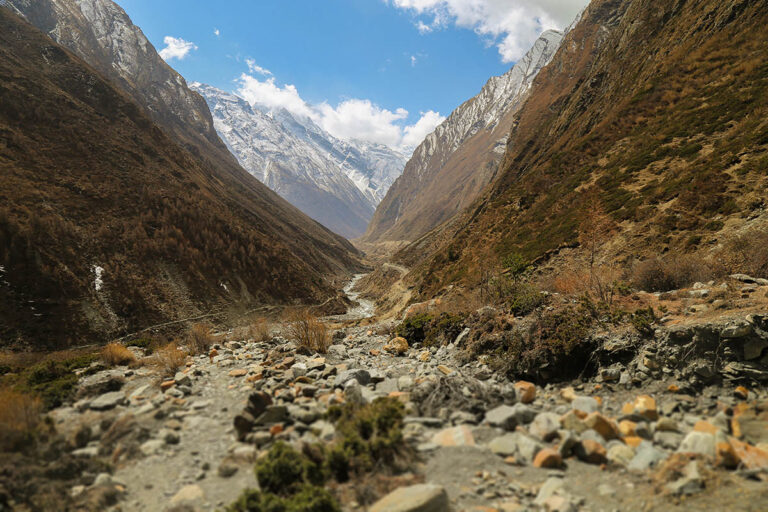Day 01 – Drive to Arughat Bazaar (608m.a.s.l.) – 7 hours drive – Arughat Bazar is 127 kilometers far from Kathmandu city; which is main entrance gate for the Manaslu circuit and Tsum Valley Trek. There are two routes to get Arughat Bazar from Kathmandu City like via Gorkha Bazar or Dhading Bensi but still regarding by the road condition the route via Dhading Bensi is better than Gorkha Bazar that takes about 6 to 7 hours, depend on transportation. During the driving period trekkers will enjoy with view of cultivated farms, River valleys, green forest and as well as massif view of Rupinala peak, Nadi Chuli and it’s beautiful ranges.
Day 02 – Trek to Lapu Bensi (884m.a.s.l) – 6 hours walk – Trek start on the flat trail pass by many small villages with the view of verdant paddy field, green landscape, charm view of Budhi Gandaki River and garden of bananas and mangoes. There isn’t any alternative trail to go Lapu Bensi so we have to walk on the dusty and rocky road until Lapu Bensi Village. There are 6 guesthouses in the Lapu Bensi Village where they serve us delicious and organic meals with great Gurung people’s hospitality.
Day 03 – Trek to Tatopani (990m.a.s.l.) – 6 hours walk – Trek begins on the flat and rocky road following by the Budhi Gandaki nibble so the temperature would be little bit hot but still most of the time we will walk on the shadow with the view of beautiful waterfalls, green hills, agricultural verdant paddy field, superb view of Shiringi Himal and very old suspension bridge which are hanging over the Budhi Gandaki river. After Lapu Bensi comes Khanibensi, Machhakhola, Khorlabesi and finally trekkers get in Tatopani Village where three basic guesthouses are available for the internal and external tourist.
Day 04 – Trek to Jagat (1340m.a.s.l.) – 6 hours walk – Trek from Tatopani to Jagat would be little bit harder than previous days due to walk on the uphill trail. After 10 to 15 minutes walk from Tatopani Village appear a suspension bridge then the trail gently ascends to the Jagat village pass by Dobhan, Thulodhunga and Yaruphat Villages. The major views of the day are huge rocky hills; Budhi Gandaki gorge and awesome waterfalls; which is can be seen near by the Yaruphat. Jagat Village is little bit bigger village than others and divided into the two parts like Lower Jagat and Upper Jagat. Upper Jagat is best for the lodge and scenery of the landscape.
Day 05 – Trek to Lokpa (1840m.a.s.l.) – 6 hours walk) – The trail lead us just bank of the Budhi Gandaki River gorge pass by Salleri, Sirdibas and Philim Village which are settlement of Gurung peoples who are depend on agriculture and animal husbandry so along the trekking trail we can see local farming style and thousand of sheep and goats are grazing over the hills. From Philim Village possible to see stunning view of the Shiringi Himal and rugged rocky hills. There is a old monastery above the Philim Village called Chyoling Samdu Gompa from there can be seen beautiful view of Shiringi Himal and Budhi Gandaki River gorge to the southward. After one-hour walk from Philim Village appears a trail junction left to the Larke Pass and right to the Tsum Valley. We will climb up an approximately one hour through the pine and rhododendron forest to get Lokpa Village where two guest houses are available with capacity of 50 people.
Day 06 – Trek to Chumling (2360m.a.s.l) – 5 hours walk – Begins of the morning the trail lead us through the temperate forest descending by gentle slope and flat trail to get a huge cave and a wonderful suspension bridge which is built at vertical cliff. The trail gently ascends from here and passes through the rhododendron forest to get top of the hill, which offers to see beautiful river valley and Rupinala peak. Rest of the trek would be pleasant due to walk on the flat trail and often-short uphill and downhill trail to get Chumling. There are half dozens of guesthouses in Chumling village and offers to see stunning view of Shiringi Himal.
Day 07 – Trek to Chhekamparo village (3010m.a.s.l) – 5 hours walk – Chhekamparo is spelled as Chhokongparo but still it’s a same place made of two villages called Chhekam and Paro. The fairly flat trail leads us to the Dumje village for two hours with tantalizing view of Ganesha Himal II 7118m, Ganesha Himal IV 7140 meters and beautiful River valley. From here, the trail ascends to the Chhekamparo village pass by hundreds of Chhortens, Mani walls, Stuapas and a scary landslide where we have to pay attention to safe with falling rocks. After three hours walk from Dumje we will arrive in Chhekamparo village that offers to see huge Mani walls; which is built by the thousands of stone slates and well carved the image of Buddhist deities and Mantras.
Day 08 – Trek to Nile Village (3347m.a.s.l) – 5 hours walk – Trek from Chhekamparo to Nile would be very pleasant due to walk mostly on the flat trail and pass by many villages called Lama gaun, Burji, Pangdum, Phubre and Chule. En route we will have fascinating wide meadows, River valley, raw of artistic Mani walls, rugged rocky hills and some of the popular religious sites of Tsum valley knows as Pirenphu cave, Milarepa cave and very old Stupas. There are only two guesthouses in Chule village but still enough for about 50 trekkers and their trekking crews. The Chule village offers to explore a beautiful Gompa called Gonhgye monastery, which is located above the Chule village and good spot to see snow-capped peaks, waterfalls and village.
Day 09 – Sight trip to Mu Gompa (3700m.a.s.l) – 5 hours round trip – Today we going to explore two major monasteries of the Tsum Valley known as Mu Gompa and Dephyudoma Nunnery Gompa which are located northwest valley of Nile village and takes about three hours to get there. Mu Gompa and Dephyudoma nunnery are main icons of the Tsum valley and believed to be more than 1000 years old. The sight trip of the day commands us to see charm landscapes, snowy peaks, wide river valley and as well as massif view of Ganesh Himal. After exploration of these religious sites we will walk down to Nile village via same trail to spend a joyful night.
Day 10 – Trek to Chhekamparo (3110m.a.s.l) – via Ranchen Monastery – 5 hours walk – We will return back to Chhekamparo Village via same trail until Phubre village then we will turn to the left hand side trail to get Ranchen monastery. Ranchen monastery is also known as Rajan Gompa; which is not only monastery but also a Buddhist school for young and kids. After exploration of Ranchen monastery we will head toward Chhekamparo village through the gigantic cultivated lands and with charms view of high Himalayas.
Day 11 – Trek to Gumba Lungdang (3200m.a.s.l) – 6 hours walk – We will walk down to Gho Village via same trail and the left hand side of trail leads us to Dumje monastery. There is not any lodge and restaurant in Dumje but still the monastery provides basic food and dormitory bed for trekkers. From here; we will climb up an approximately three hours to get Gumba Lungdang. Gumba Lungdang is 600 years old monastery where 8 to 10 old nuns are living and meditating. Sight trip of Gumba Lungdang offers to see stunning view of Ganesha Himal, Boudha Himal, Himal Chuli and beautiful forest of Rhododendron.
Day 12 – Sight trip to Ganesha Himal Base Camp (4200m.a.s.l) – 8 to 9 hours round trip – Sight trip to Ganesha Himal Base Camp might be one of the memorable trip of the whole trek due to see spectacular view of mountains, walking through the dense forest of pine and rhododendrons, crossing the river on a wooden bridge and step the glacier. The trail to Ganesha Himal Base Camp makes you little bit tired cause by up and downhill trail so trekkers have to carry enough drinking water and as well as pack lunch.
Day 13 – Trek to Lokpa (2240m.a.s.l) – 7 hours walk – We walk down to Dumje Village through the dense forest of rhododendron and cross Lungdang river on a wooden bridge just lower the Dumje Village and then the trail leads to Ripchet Village ascending by gradual trail with the view of Chumchet Village, Siyar River Valley, rocky hills and as well as the view of Himal Chuli. Ripchet Village is a beautiful ancient Tibetan settlement where can be seen wonderful houses, artistic Chhortens and monasteries which are built by the stone slabs and wooden logs. From Ripchet Village we ascend about 35 minutes to the Ghum Long Bhatti then head towards Lokpa where we have spent a night when we walked up to Chumling Village.
Day 14 – Trek to Jagat (1340m.a.s.l) – 5 hours – After half an hour walk downhill trail we will be at the junction point of Manaslu circuit trek and way to Tsum Valley and then we will head to Jagat Village Pass by the Ekle Bhatti, Philim, Sirdibas and Salleri Village. Along the trekking trail we will enjoy with the view of Shiringi Himal, rugged rocky hills, Agricultural terraced field and the local people’s activities.
Day 15 – Trek to Machhakhola (870m.a.s.l) -6 hours walk – there isn’t any alternative trail to get back to Arughat Bazaar so we will walk down via same trail that we have taken when we climb up to Tsum valley. The trail lead us through the deep gorge pass by many small villages called yaruphat, Thulodhunga, Dobhan, Tatopani, Khorlabesi and finally after 6 hours walk we will be in Machhakhola Village where dozen of guest houses are available and they provide us comfortable bed and delicious meal.
Day 16 – Trek to Soti Khola (690m.a.s.l) – 6 hours walk – Trek of the day would be easy and pleasant walk due to the flat and gradual up trail. Along the day we will enjoy with the huge rocky hills, waterfalls, green forest, agricultural terraced field, gurgle sound of the Budhi Gandaki River and many villages which are dramatically settled over the vertical land. Normally, trekkers stop in Lapu Bensi Village to have lunch. After lunch we will head to Arkhet Bazar that may takes about another three hours. There are half dozen of guesthouses are providing lodge and meals for the trekkers.
Day 17 – Trek to Arughat Bazar (608m.a.s.l.) – 4 hours walk – Today we will walk through the verdant paddy field following by the Budhi Gandaki river so the trek would be very easy because of the flat trail and the view of paddy terraced, huge garden of bananas and mangoes. Along the day we will meet many local peoples who are working in the farm and garden. We will be in Arughat Bazar later in the afternoon so after lunch we will explore the Bazaar.
Day 18 – Drive back to Kathmandu -7 hours drive – After breakfast we will drive back to Kathmandu City, which is 127 kilometer far from Arughat Bazar and may takes approximately seven hours depend on our transportation.
